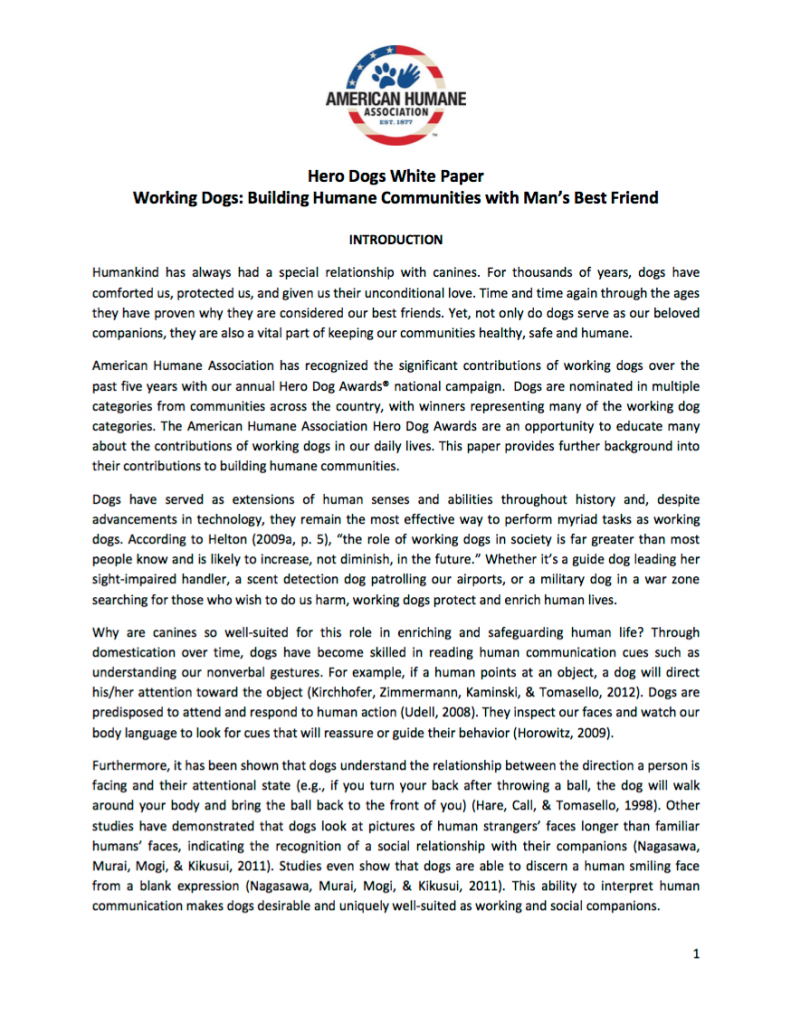Introduction
Humankind has always had a special relationship with canines. For thousands of years, dogs have comforted us, protected us, and given us their unconditional love. Time and time again through the ages they have proven why they are considered our best friends. Yet, not only do dogs serve as our beloved companions, they are also a vital part of keeping our communities healthy, safe and humane.
American Humane has recognized the significant contributions of working dogs over the past five years with our annual Hero Dog Awards® national campaign. Dogs are nominated in multiple categories from communities across the country, with winners representing many of the working dog categories. The American Humane Hero Dog Awards are an opportunity to educate many about the contributions of working dogs in our daily lives. This paper provides further background into their contributions to building humane communities.
Dogs have served as extensions of human senses and abilities throughout history and, despite advancements in technology, they remain the most effective way to perform myriad tasks as working dogs. According to Helton (2009a, p. 5), “the role of working dogs in society is far greater than most people know and is likely to increase, not diminish, in the future.” Whether it’s a guide dog leading her sight-impaired handler, a scent detection dog patrolling our airports, or a military dog in a war zone searching for those who wish to do us harm, working dogs protect and enrich human lives.
Why are canines so well-suited for this role in enriching and safeguarding human life? Through domestication over time, dogs have become skilled in reading human communication cues such as understanding our nonverbal gestures. For example, if a human points at an object, a dog will direct his/her attention toward the object (Kirchhofer, Zimmermann, Kaminski, & Tomasello, 2012). Dogs are predisposed to attend and respond to human action (Udell, 2008). They inspect our faces and watch our body language to look for cues that will reassure or guide their behavior (Horowitz, 2009).
Furthermore, it has been shown that dogs understand the relationship between the direction a person is facing and their attentional state (e.g., if you turn your back after throwing a ball, the dog will walk around your body and bring the ball back to the front of you) (Hare, Call, & Tomasello, 1998). Other studies have demonstrated that dogs look at pictures of human strangers’ faces longer than familiar humans’ faces, indicating the recognition of a social relationship with their companions (Nagasawa, Murai, Mogi, & Kikusui, 2011). Studies even show that dogs are able to discern a human smiling face from a blank expression (Nagasawa, Murai, Mogi, & Kikusui, 2011). This ability to interpret human communication makes dogs desirable and uniquely well-suited as working and social companions.
However, not all dogs are effective as working dogs. Certain traits and behaviors are required, along with copious amounts of training, for dogs to succeed as working companions. Data suggests that success rates average only 50% across the various working dog sectors (Arnott, Early, Wade, & McGreevy, 2014a, 2014b). This statistic underscores the need to have an enhanced understanding of what it takes to be a working dog and how we can ensure the health and well-being of these important animals. As such, this white paper focuses on the different types of working dogs, how they are trained, and how they benefit society.

